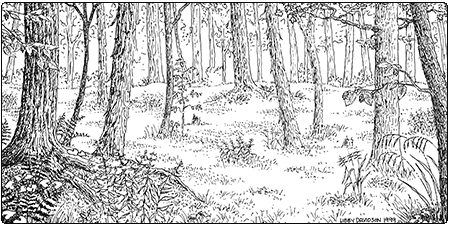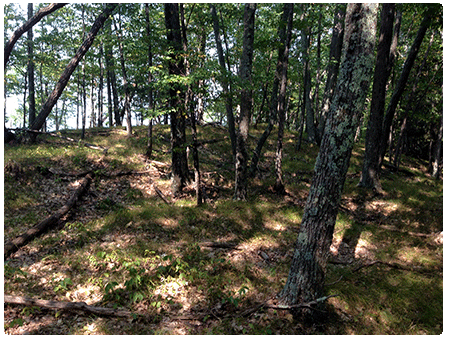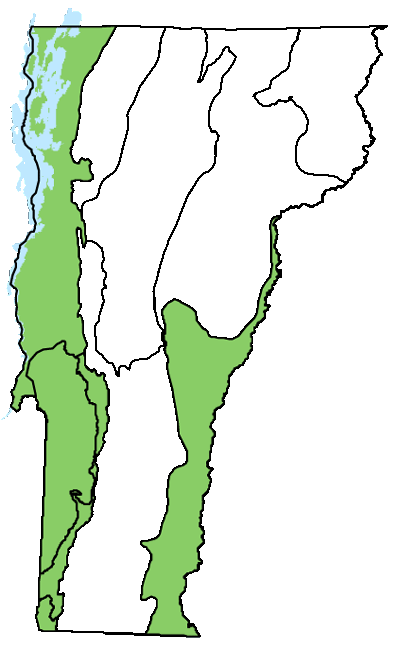Ecology and Physical Setting 
These are open, park-like forests where shrubs are sparse—one can see a long distance through the woods. Such open forests are uncommon in Vermont, and visitors find them exceptionally beautiful. Dry Oak-Hickory-Hophornbeam Forests are found on hilltops, gentle ridgelines, knobs, benches, and other small rises. A combination of warm climates, shallow soils, and landforms that shed water creates a specific set of site conditions. Bedrock is various, ranging from calcareous to acidic, but there are almost always some plants indicating soil enrichment. Trees do not grow as well as they do on deeper, moister soils. Many forests of this type are found on the rocky portions of Champlain Valley farms. In most cases they were never cleared for pasture or crops but were often used as woodland pasture. Natural and anthropogenic disturbances probably contribute to the structure of Dry Oak-Hickory-Hophornbeam Forests.
Vegetation
Red oak, shagbark hickory, and hophornbeam are the common canopy dominants. Sugar maple, white ash, and white oak can be present, and even abundant, in the most enriched examples. The canopy is somewhat open, and trees do not reach great height. The shrub layer is very sparse. The ground layer is often a dense lawn of woodland sedge, with a diverse array of herbs scattered about. In areas of calcareous bedrock, rare species abound.
Wildlife Habitat
The melodic, flute-like call of the wood thrush and the plaintive call of the wood pewee are just some of the attractions of Dry Oak-Hickory-Hophornbeam Forests. Other nesting birds include white-breasted nuthatch, scarlet tanager, red-eyed vireo, rose-breasted grosbeak, and Baltimore oriole. The nutlets of hophornbeam are important food for turkeys, rose-breasted grosbeaks, gray squirrels, and chipmunks. Hickory nuts and the acorns of red and white oak are important for turkey, black bear, squirrels, and chipmunks.
The entirely terrestrial eastern red-backed salamander may be abundant, especially in older forests with lots of downed and decaying wood.
Three rare reptiles—timber rattlesnake, eastern ratsnake, and the five-lined skink—are all found in Dry Oak-Hickory-Hophornbeam Forests in specific areas of Vermont. Hickory is the primary host plant for the caterpillar stage of the uncommon hickory hairstreak butterfly. The large plates of exfoliating bark on mature shagbark hickory provide roosting sites for two rare bats: Indiana bat and northern long-eared bat.
Successional Trends
Sugar maple, red oak, white oak, shagbark hickory, and hophornbeam are all likely late-successional canopy components. Fire has played a role in some examples of this community, but whether fire is necessary to maintain these forests is not known.
Variants
- Sugar Maple-Hophornbeam Forest also occurs on water-shedding ridgetops, but is found in slightly cooler and moister climates. It is dominated by sugar maple, with hophornbeam and red oak, but lacks shagbark hickory. White ash can be locally abundant. The structure and composition of the shrub and herb layers is very similar to typical Dry Oak-Hickory-Hophornbeam Forests.
Related Communities
- Dry Oak Forest is more nutrient-poor or has bedrock closer to the surface, or both. Red oak, white oak, and chestnut oak dominate, and heath shrubs are common in the ground layer. Woodland sedge may be common in these forests, as it is in Dry Oak-Hickory-Hophornbeam Forest.
- Mesic Maple-Ash-Hickory-Oak Forest is found on lower slopes, where soils are deeper and moisture is more available to plants. The two communities often grade into each other.
Conservation Status and Management Considerations
Dry Oak-Hickory-Hophornbeam Forest is an uncommon community, with only a handful of large, natural examples known. Smaller patches of this community type are moderately common in the Champlain Valley. Some excellent examples are protected on conserved lands. Calcareous examples of this community are especially vulnerable to invasion by non-native species. Any management activities should include efforts to control invasives.
Distribution/Abundance
This community has southern affinities and is found in the warmer parts of Vermont as well as in surrounding states. Most examples are in the Champlain Valley and Taconic Mountains, although the community is also known from the Southern Vermont Piedmont, and the Vermont Valley. Isolated occurrences may be found in some of the warmest areas of the Southern Green Mountains and the Champlain Hills.
Characteristic Plants
Trees
Abundant Species
Red oak – Quercus rubra
Hophornbeam – Ostrya virginiana
Shagbark hickory – Carya ovata
Occasional to Locally Abundant Species
White oak – Quercus alba
Sugar maple – Acer saccharum
White ash – Fraxinus americana
Shrubs
Occasional to Locally Abundant Species
Maple-leaved viburnum – Viburnum acerifolium
Downy arrowwood – Viburnum rafinesquianum
Herbs

Abundant Species
Woodland sedge – Carex pensylvanica
Occasional to Locally Abundant Species
Hog peanut – Amphicarpaea bracteata
Bottlebrush grass – Elymus hysterix
Blue-stemmed goldenrod – Solidago caesia
Pedunculate sedge – Carex pedunculata
Broad-leaved sedge – Carex platyphylla
Wild oats – Uvularia sessilifolia
Furry brome – Bromus pubescens
Blunt fescue - Festuca obtusa
Black-seeded mountain rice – Patis racemosa
Four-leaved milkweed – Asclepias quadrifolia
Rare and Uncommon Plants
Yellow oak – Quercus muehlenbergii
Wood lily – Lilium philadelphicum
Hitchcock’s sedge – Carex hitchcockiana
Forked chickweed – Paronychia canadensis
Allegheny crowfoot – Ranunculus allegheniensis
Early blue violet – Viola palmata
Deerberry – Vaccinium stamineum
Hound’s tongue – Cynoglossum boreale
Hairy honeysuckle – Lonicera hirsuta
Rue anemone – Thalictrum thalictroides
Back’s sedge – Carex backii
Rock muhlenbergia – Muhlenbergia sobolifera
Slender-flowered muhlenbergia – Muhlenbergia tenuiflora
Pignut hickory – Carya glabra
Early blue violet – Viola palmata
Rattlesnake-weed – Hieracium venosum
Downy arrowwood – Viburnum rafinesquianum
Kalm’s brome grass – Bromus kalmii
Fragrant sumac – Rhus aromatica
Longleaf bluet – Houstonia longifolia
Associated Animals
Eastern red-backed salamander – Plethodon cinereus
Eastern gray squirrel – Sciurus carolinensis
Southern flying squirrel – Glaucomys volans
Eastern chipmunk – Tamias striatus
White-breasted nuthatch – Sitta carolinensis
Scarlet tanager – Piranga olivacea
Eastern wood pewee – Contopus virens
Red-eyed vireo – Vireo olivaceus
Ovenbird – Seiurus aurocapilla
Baltimore oriole – Icterus galbula
Wood thrush – Hylocichla mustelina
Wild turkey – Meleagris gallopavo
Hairy woodpecker – Picoides villosus
Rose-breasted grosbeak – Pheucticus ludovicianus
Tufted titmouse – Baeolophus bicolor
Rare and Uncommon Animals
Eastern ratsnake – Pantherophis alleghaniensis
Common five-lined skink – Plestiodon fasciatus
Timber rattlesnake – Crotalus horridus
Indiana bat – Myotis sodalist
Northern long-eared bat – Myotis septentrionalis
Hickory hairstreak – Satyrium caryaevorus
Places to Visit
Shaw Mountain Natural Area, Benson, The Nature Conservancy (TNC).
Helen W. Buckner Memorial Preserve at Bald Mountain, West Haven, TNC
Mount Philo State Park, Charlotte, Vermont Department of Forests, Parks, and Recreation
Little Ascutney Wildlife Management Area, Weathersfield, Vermont Fish and Wildlife Department
